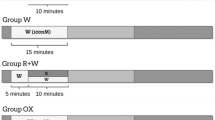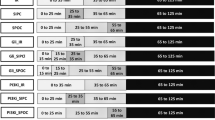Abstract
Ischemic preconditioning (IPC) is one of the most powerful interventions to reduce ischemia-reperfusion injury. The aim of the present study was to investigate the involvement of the phosphatidylinositol-3-kinases (PI3Ks) family in cardioprotection exerted by IPC and the relationship between preservation of mitochondrial morphology and ATP synthesis capacity. In this regard, macroautophagy (autophagy) is considered a dynamic process involved in the replacement of aged or defective organelles under physiological conditions. IPC consisted of four 5-min cycles of ischemia-reperfusion followed by sustained ischemia. Wortmannin (W), a PI3K family inhibitor, was added to the perfusion medium to study the involvement of autophagy in the beneficial effects of IPC. In the present study, LC3-II/I expression was significantly increased in the IPC group when compared with the control group. The hearts subjected to IPC showed greater degradation of p62 than control groups, establishing the existence of an autophagic flow. Electron microscopy showed that IPC preserves the structural integrity of mitochondria after ischemia and at the end of reperfusion. Moreover, hearts subjected to IPC exhibited increased mitochondrial ATP synthesis. The beneficial effects of IPC were abolished by W in all trials of this study, abolishing the differences between the IPC and control groups. These results suggest that IPC could partly reduce injury by ischemia-reperfusion (I/R) by decreasing mitochondrial damage and promoting autophagy. Since W is a nonspecific inhibitor of the PI3Ks family, further research is required to confirm participation of PI3K in the response to IPC.





Similar content being viewed by others
References
Blommaart EF, Krause U, Schellens JP, Vreeling-Sindelárová H, Meijer AJ (1997) The phosphatidylinositol 3-kinase inhibitors wortmannin and LY294002 inhibit autophagy in isolated rat hepatocytes. Eur J Biochem 243(1–2):240–246
Bolli R (2007) Preconditioning: a paradigm shift in the biology of myocardial ischemia. Am J Physiol Heart Circ Physiol 292:H19–H27
Bradford MM (1976) A rapid and sensitive method for the quantitation of microgram quantities of protein utilizing the principle of protein-dye binding. Anal Biochem 72:248–254
Brown WJ, De Wald DB, Emr SD, Plunter H, Balch WE (1995) Role for phosphatidylinositol 3-kinase in the sorting and transport of newly synthesized lysosomal enzymes in mammalian cells. J Cell Biol 130:781–796
Clague MJ, Thorpe C, Jones AT (1995) Phosphatidylinositol 3-kinase regulation of fluid phase endocytosis. FEBS Lett 367:272–274
Clarke JF, Young PW, Yonezawa K, Kasuga M, Holman GD (1994) Inhibition of the translocation of GLUT1 and GLUT4 in 3T3-Ll cells by the phosphatidylinositol 3-kinase inhibitor, wortmannin. Biochem J 300:631–635
Decker RS, Wildenthal K (1980) Lysosomal alterations in hypoxic and reoxygenated hearts; Ultrastructural and cytochemical changes. Am J Pathol 98(2):425–444
Dirksen MT, Laarman GJ, Simoons ML, Duncker DJ (2007) Reperfusion injury in humans: a review of clinical trials on reperfusion injury inhibitory strategies. Cardiovasc Res 74:343–355
Fruman DA, Meyers RE, Cantley LC (1998) Phosphoinositide kinases. Annu Rev Biochem 67:481–507
Gottlieb R, Mentzer R (2013) Autophagy: an affair of the heart. Heart Fail Rev 18:575–584. doi:10.1007/s10741-012-9367-2
Gustafsson AB, Gottlieb RA (2008) Recycle or die: the role of autophagy in cardioprotection. J Mol Cell Cardiol 44(4):654–661. doi:10.1016/j.yjmcc.2008.01.010.
Hausenloy DJ, Tsang A, Mocanu MM, Yellon DM (2005) Ischemic preconditioning protects by activating prosurvival kinases at reperfusion. Am J Physiol Heart Circ Physiol 288(2):H971–H976
Hausenloy DJ, Yellon DM (2007) Preconditioning and postconditioning: united at reperfusion. PharmacolTher 116:173–191
Huang C, Andres AM, Ratliff EP, Hernandez G, Lee P, Gottlieb RA (2011) Preconditioning involves selective mitophagy mediated by Parkin and p62/SQSTM1. PLoS One 6(6):e20975. doi:10.1371/journal.pone.0020975
Ji L, Zhang X, Liu W, Huang Q, Yang W, Fu F, Ma H, Su H, Wang H, Wang J, Zhang H, Gao F (2013) AMPK-regulated and Akt-dependent enhancement of glucose uptake is essential in ischemic preconditioning-alleviated reperfusion injury. PLoS One 8(7):e69910. doi:10.1371/journal.pone.0069910
Jones AT, Clague MJ (1995) Phosphatidylinositol 3-kinase activity is required for early endosome fusion. Biochem J 311:31–34
Kapeller R, Cantley LC (1994) Phosphatidylinositol 3-kinase. Bioessays 8:565–576
Lavandero S, Troncoso R, Rothermel BA, Martinet W, Sadoshima J, Hill JÁ (2013) Cardiovascular autophagy: concepts, controversies and perspectives. Autophagy 9(10):1455–1466. doi:10.4161/auto.25969
Lowry OH, Rosebrough NJ, Farr AL, Randall RJ (1951) Protein measurement with the Folin phenol reagent. J Biol Chem 193:265–275
Maiuri MC, Zalckvar E, Kimchi A, Kroemer G (2007) Self-eating and self-killing: crosstalk between autophagy and apoptosis. Mol Cell Biol 8:741–752
Marina Prendes MG, González M, Savino E, Varela A (2007) Role of endogenous nitric oxide in classic preconditioning in rat hearts. Reg Pep 139:141–145
Marina Prendes MG, Hermann R, Torresin ME, Vélez D, Savino E, Varela A (2014) Role of mitochondrial permeability transition pore and mitochondrial ATP-sensitive potassium channels in the protective effects of ischemic preconditioning in isolated hearts from fed and fasted rats. J Physiol Biochem 70:791–800. doi:10.1007/s13105-014-0347-y
Mizushima N, Komatsu M (2011) Autophagy: renovation of cells and tissues. Cell 147:728–741. doi:10.1016/j.cell.2011.10.026
Mizushima N, Yoshimori T (2007) How to interpret LC3 immunoblotting. Autophagy 3(6):542–545
Murry CE, Jennings RB, Reimer KA (1986) Preconditioning with ischemia: a delay of lethal cell injury in ischemic myocardium. Circulation 74:1124–1136
Petiot A, Ogier-Denis E, Blommaart EF, Meijer AJ, Codogno P (2000) Distinct classes of phosphatidylinositol 3′-kinases are involved in signaling pathways that control macroautophagy in HT-29 cells. J Biol Chem 275(2):992–998
Post H, Heusch G (2002) Ischemic preconditioning. Experimental facts and clinical perspective. Minerva Cardioangiol 50(6):569–605
Przyklenk K, Dong Y, Undyala VV, Whittaker P (2012) Autophagy as a therapeutic target for ischaemia/reperfusion injury? Concepts, controversies, and challenges. Cardiovasc Res 94(2):197–205. doi:10.1093/cvr/cvr358.
Quarrie R, Lee DS, Steinbaugh G, Cramer B, Erdahl W, Pfeiffer DR, Zweier JL, Crestanello JA (2012) Ischemic preconditioning preserves mitochondrial membrane potential and limits reactive oxygen species production. J Surg Res 178(1):8–17. doi:10.1016/j.jss.2012.05.090
Shiomi M, Miyamae M, Takamura G, Kaneda K, Inamura Y, Onishi A, Koshinuma S, Momota Y, Minami T, Figueredo V (2014) Induction of autophagy restores the loss of sevoflurane cardiac preconditioning seen with prolonged ischemic insult. Eur J Pharmacol 724:58–66. doi:10.1016/j.ejphar.2013.12.027
Solani G, Harris DA (2005) Biochemical dysfunction in heart mitochondria exposed to ischaemia and reperfusion. Biochem J 390:377–394. doi:10.1042/BJ20042006
Solem L, Wallace K (1993) Selective activation of the sodium-independent, cyclosporin A-sensitive calcium pore of cardiac mitochondria by doxorubicin. Toxicol Appl Pharmacol 121:150–157
Thapalia BA, Zhou Z, Lin X (2014) Autophagy, a process within reperfusion injury: an update. Int J Clin Exp Pathol 7(12):8322–8341
Uchiyama T, Engelman RM, Maulik N, Das DK (2004) Role of Akt-signaling in mitochondrial survival pathway triggered by hypoxic preconditioning. Circulation 109(24):3042–3049
Varela A, Marina Prendes MG, Testoni G, Vázquez N, Astudilla C, Cerruti S, Savino E (2002) Influence of fasting on the effects of ischemic preconditioning in the ischemic-reperfused rat heart. Arch Physiol Biochem 110:250–261
Acknowledgments
The authors thank Norma Gladys Infante for technical assistance. This research was supported in part by grants from the University of Buenos Aires, the National Scientific and Technical Research Council (CONICET PIP 0774) and the Institute of Drug Chemistry and Metabolism (IQUIMEFA-CONICET).
Author information
Authors and Affiliations
Corresponding author
Ethics declarations
Conflict of interest
The authors declare that they have no conflict of interest.
Rights and permissions
About this article
Cite this article
Vélez, D.E., Hermann, R., Frank, M.B. et al. Effects of wortmannin on cardioprotection exerted by ischemic preconditioning in rat hearts subjected to ischemia-reperfusion. J Physiol Biochem 72, 83–91 (2016). https://doi.org/10.1007/s13105-015-0460-6
Received:
Accepted:
Published:
Issue Date:
DOI: https://doi.org/10.1007/s13105-015-0460-6




